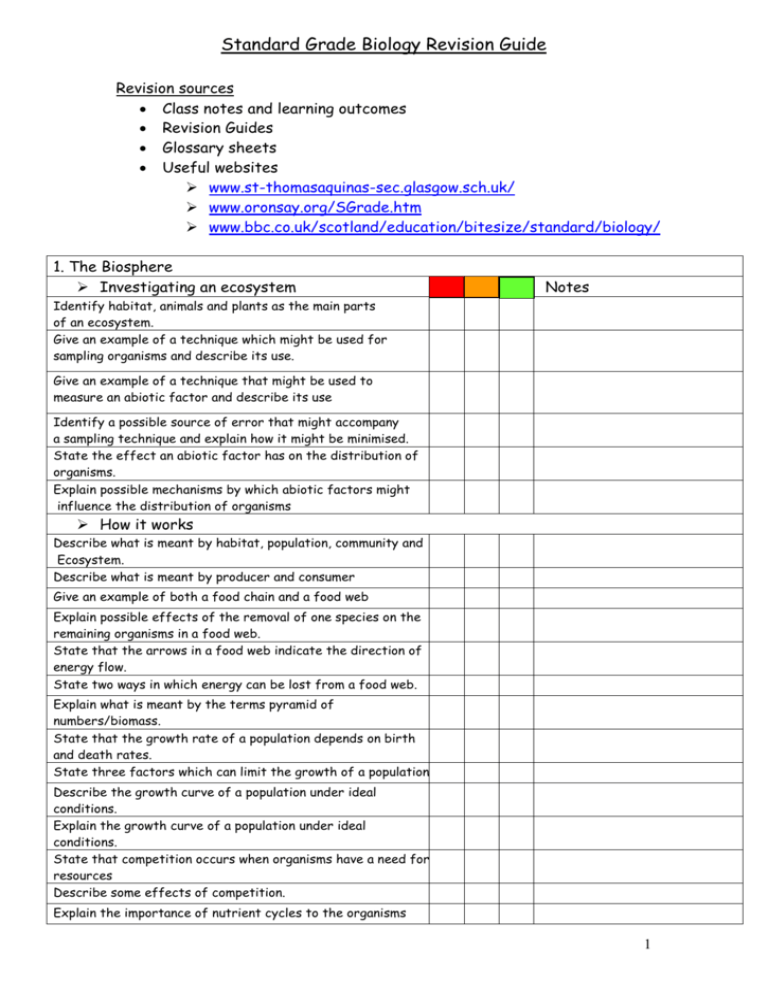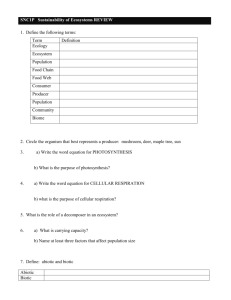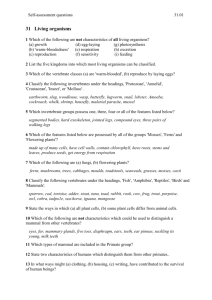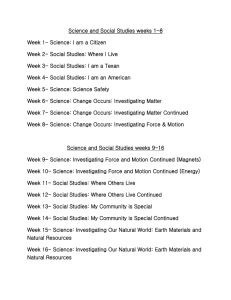Standard Grade Biology Revision Guide
advertisement

Standard Grade Biology Revision Guide Revision sources Class notes and learning outcomes Revision Guides Glossary sheets Useful websites www.st-thomasaquinas-sec.glasgow.sch.uk/ www.oronsay.org/SGrade.htm www.bbc.co.uk/scotland/education/bitesize/standard/biology/ 1. The Biosphere Investigating an ecosystem Notes Identify habitat, animals and plants as the main parts of an ecosystem. Give an example of a technique which might be used for sampling organisms and describe its use. Give an example of a technique that might be used to measure an abiotic factor and describe its use Identify a possible source of error that might accompany a sampling technique and explain how it might be minimised. State the effect an abiotic factor has on the distribution of organisms. Explain possible mechanisms by which abiotic factors might influence the distribution of organisms How it works Describe what is meant by habitat, population, community and Ecosystem. Describe what is meant by producer and consumer Give an example of both a food chain and a food web Explain possible effects of the removal of one species on the remaining organisms in a food web. State that the arrows in a food web indicate the direction of energy flow. State two ways in which energy can be lost from a food web. Explain what is meant by the terms pyramid of numbers/biomass. State that the growth rate of a population depends on birth and death rates. State three factors which can limit the growth of a population Describe the growth curve of a population under ideal conditions. Explain the growth curve of a population under ideal conditions. State that competition occurs when organisms have a need for the same resources Describe some effects of competition. Explain the importance of nutrient cycles to the organisms 1 of an ecosystem. Describe the sequence of processes in the nitrogen cycle. Control & Management State that pollution affects air, fresh water, sea and land State that the main sources of pollution are domestic, agricultural and industrial, giving an example of a pollutant from each. Explain an adverse effect of using fossil fuels and nuclear power as energy resources. Give an example of one way in which pollution may be controlled. State that organic waste is a food source for microorganisms Describe the effect of increased numbers of microorganisms on the oxygen available to other organisms. Explain the relationship between level of pollution with organic waste, numbers of micro-organisms, oxygen concentration and number of species. Explain what is meant by indicator species. Give 2 examples of poor management of natural resources and suggest possible improvements. Describe how the effect of poor management of natural resources can produce problems. Explain how components of an ecosystem are controlled in either agricultural or forestry 2. Investigating Cells Investigating living Cells Notes State that cells are the basic units of living things. Explain the purpose of staining animal and plant cells. Describe the structural similarities of and differences between animal and plant cells. Investigating Diffusion State that a substance can diffuse from a high concentration to a low concentration State that the cell membrane controls the passage of substances into and out of the cell Explain the importance of diffusion to organisms Give examples of substances which enter and leave the cell by diffusion, e.g. dissolved food, oxygen, carbon dioxide and water. Identify osmosis as a ‘special case’ of the diffusion of water Explain osmosis in terms of a selectively permeable membrane and of a concentration gradient. Explain observed osmotic effects in plants and in animal cells in terms of the concentration of water in the solutions involved. Investigating Cell Division (mitosis) State that cell division is a means of increasing the number 2 of cells in an organism State that the nucleus of the cell controls cell activities including division. State that each of the two cells produced by cell division has a complete set of chromosomes and the same genetic information. Describe and explain the stages of mitosis. Explain why it is important that the chromosome complement of daughter cells in multi-cellular organisms is maintained. Identify the correct sequence of stages of mitosis. Investigating Enzymes Explain why enzymes are required for the functioning of living cells Explain the meaning of the term ‘catalyst’ Give an example of an enzyme involved in the chemical breakdown of a substance (degradation). Give an example of an enzyme involved in synthesis. Explain the term ‘specific’ as applied to enzymes and their Substrates. State that enzymes are proteins. Describe the effect of temperature on enzyme activity Describe the effect of a range of pH on the activity of pepsin and catalase. Explain the term optimum as applied to the range of conditions in which enzymes operate. Investigating Aerobic Respiration State three reasons why living cells need energy State that fats and oils contain more chemical energy per gram than carbohydrates or proteins. State that cells need oxygen to release energy from food during aerobic respiration. Describe aerobic respiration in terms of a word equation. State that carbon dioxide is given off by cells during tissue respiration and is derived from food. State that heat energy may be released from cells during respiration. Explain the importance of energy released from food during Respiration, to the metabolism of cells. 3. World of Plants Introducing Plants Notes Give examples of advantages of there being a wide variety of plants. Explain possible consequences to man and other animals of the reduction in the variety of species. Describe three specialised uses of plants. Describe timber production. Describe two potential uses of plants or plant products e.g. new medicines, new food sources. 3 Growing Plants Describe the function of the three main parts of a seed Describe the effect of temperature and the availability of water and oxygen on germination. Describe the function of the parts of the flower e.g. sepal, petals, stamen, anther, stigma, ovary, nectary. Describe methods of pollination. Describe fertilisation and fruit formation. Describe ways of propagating flowering plants artificially by cuttings and graftings. Describe asexual reproduction by runners and tubers. Describe the changes in percentage germination that occur over a range of temperatures. Explain the structure of wind- and insect-pollinated flowers in relation to sexual reproduction. Describe the growth of the pollen tube and fusion of gametes. Describe one example of each of the following different dispersal mechanisms: wind, animal –internal, animal – external Explain the advantages of artificial propagation in flowering plants. Describe what is meant by the term ‘clone’. Describe the advantages of both sexual and asexual reproduction to plants. Making Food Explain the need for a transport system in plants. Describe the structure of phloem and xylem and identify other functions of the transport system. Describe the pathways of movement of water and food in xylem and phloem. Know that plants take in carbon dioxide from the air through stomata which can open and close. Know that water vapour is lost through stomata. Describe the external features and internal structure (epidermis, mesophylls, veins) of a leaf in relation to its function of gas exchange. Know that green plants make their own food which may be stored as starch. Describe the fate of carbon dioxide as structural and storage carbohydrates in plants and as energy sources. Know that green plants convert light energy to chemical energy using chlorophyll. Describe the process of photosynthesis in terms of raw materials and products. Explain what is meant by a limiting factor and describe the main limiting factors in the process of photosynthesis. 4 4. Animal Survival The Need for Food Notes Explain why food is required by animals. State the chemical elements present in carbohydrates, proteins and fats. Describe the simple structure of carbohydrates, proteins and fats in terms of simple sugars, amino acids, fatty acids and glycerol. State that digestion is the breakdown of large particles of food into smaller particles to allow absorption into the bloodstream through the small intestine. Explain that digestion involves the breakdown of insoluble food substances into soluble food substances. Describe the role of different types of teeth in the mechanical breakdown of food in a herbivore, a carnivore and an omnivore such as a human. Identify in a diagram the main parts of the alimentary canal and associated organs. State the sites of production of the main digestive juices in a mammal. Explain the mechanism of peristalsis. Give an example of an amylase, a protease and a lipase. State the substrates and products. Explain how contractions of the stomach help in the chemical breakdown of food. Explain how the small intestine is related to its function. Explain how the structure of the villus including the lacteal and the blood capillaries, are related to the absorption and transport of food. Describe the role of the large intestine in water absorption and elimination. Reproduction Describe the main features of sperm and egg sex cells. Describe the process of fertilisation. State that in some fish, sperm are deposited in water adjacent to the eggs and that in mammals; sperm are deposited in the body of the female. Explain the importance of internal fertilisation to land living animals. State that sperm cells are produced in the testes. State that eggs are produced in the ovaries and are released into the oviducts, where fertilisation takes place. State that in fish, eggs are protected by flexible coverings and that the embryos obtain food from enclosed yolk. Explain the relationship between the number of eggs/young produced and the degree of protection afforded during fertilisation and development in fish and mammals. Describe how the fertilised egg passes down the oviduct and becomes attached to the wall of the uterus, develops in the fluid of the amniotic sac and obtains food from the maternal circulation. 5 Describe the structure and function of the placenta. State that in a fish like trout, the young emerge from the eggs able to maintain themselves. State that at birth, the young of mammals are dependant on the adult for care and protection. Water & Waste Identify the ways in which a mammal gains and loses water. State that the kidneys are the main organs for regulating the water content in a mammal. Explain the role of ADH in the regulation of water balance. Identify the position, and state the functions of the kidneys, renal arteries and veins, ureter and bladder. State that essential kidney functions are filtration of blood and re-absorption of useful materials such as glucose. Explain the process of urine production using a simple diagram of the nephron, to include the Bowmans Capsule, glomerulus, blood capillaries and collecting duct. State that urea is a waste product removed in the urine. State the source of urea in the body and describe how urea is transported to the kidneys. Explain the implications of damage to the kidneys by accidents or disease. Describe the benefits and limitations of replacement and artificial kidneys. Responding to the environment Give examples of environmental factors which affect behaviour. Describe the response of an animal to change in one environmental factor. Explain the significance of given examples of response to environmental stimuli in the life of an organism. Describe examples of rhythmical behaviour and in each case identify the external trigger. Explain the significance of given examples of rhythmical behaviour in the life of the organism. 5. The Body In Action Movement State that the skeleton provides a framework for support and muscle attachment. State that the skeleton protects the heart, lungs, brain and spinal cord. Describe the range of movements allowed by a ball and socket joint and a hinge joint. State the functions of ligaments and cartilage at a joint. Describe the structure of a synovial joint and state the function of its parts. State that bone is composed of flexible living fibres and hard minerals (calcium phosphate). State that bone is formed by living cells. 6 State that the muscles are attached to bones by tendons. Explain why tendons are inelastic. Describe how movement is brought about by muscle contraction. Explain the need for a pair of opposing muscles at a joint. Need for Energy State the effects of an imbalance between energy input and energy output. State that oxygen is absorbed and carbon dioxide is released. in breathing Describe the internal structure of the lungs. (trachea/brochi/bronchioles/alveoli) Describe the mechanism of breathing in humans. Explain the function of cilia, cartilage and mucus in the trachea and bronchi. Describe gas exchange between air sacs and surrounding blood vessels. Describe the features which make lungs efficient gas exchange structures. Identify the four chambers of the heart. Describe the path of blood flow through the heart and its associated blood vessels. Describe the positions and functions of the heart valves. Explain the difference in the thickness of the walls of the Ventrcles. State that the heart obtains its blood supply from the coronary arteries State that blood leaves the heart in arteries, flows through capillaries and returns to the heart in veins. State that the pulse indicates that blood is flowing through an artery. Describe the function of red blood cells and plasma in the transport of respiratory gases and food. Describe gas exchange between the body cells and the surrounding capillaries. 7








